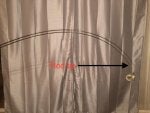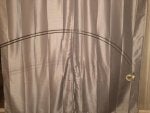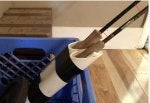Just wondering what everyone's opinion is on deflection tests. Since I'm still learning everything I can about rod actions as I buy - fish - sell numerous rods a year while filling my quiver, I've enjoyed Yellowstone Anglers deflection tests and built my own to mirror theirs. I just got a new Sage XP 4wt in last night that's in like new condition. It appears to be a newer model than the two XP's I bought my girl friend. But I compared her 5 wt to my new 4 wt in the deflection tester and the rods have an identical bending profile. The 4 wt was maybe 1/2" higher with a stiffer blank. That surprised me. I was expecting the 4wt to bend more with the rod tip lower with the same 3.8oz of weight. Anyone have thoughts on this result?
View attachment 14842
Yes sir - I have two 1 1/4' PVC pipes taped together to load the rods in and make sure they match exactly even in length and 45 degree angle before adding the 3.8oz to each rod tip. I was definitely expecting the 4 wt rod tip to land 3" below the 5 wt's. Here's a picture of the set up with a Sage 5 wt and my Winston B3X 5wt to give you an idea. Works great.
View attachment 14846
I will admit that the results are unusual.
If that happened to me, I would check and recheck.
1. I would switch the weights in the first photo to see if the wts are in fact identical.
2. In the second photo, the cork handles are different and at that would change the angle of the in the PVC tube. I assume that the paper toweling cushioning the Sage is to palace the rods at the same angle AND to EXACTLY align the blank. UNLESS the blank is exactly aligned, the test is not valid. The two rods in the second photo are diverging at the right upper corner. Is this due to the angle at which the photo was taken or is this because the rods are under stress?
3. I disagree that the rods have identical flex based on the first photo.
There is something wrong with the first photograph which I show in the photo below. The rod tips are at the SAME level. If the rod butts are at the same level and are at the same angle, AND the one rod bends MORE than the OTHER, the rod tip of the rod that bends MORE MUST BE LOWER. They are not. The rod tips are at the same level as I have label in the annotated image below.

The only way this can occur is if the rod associated at the rod tip closest to the arrow actually slightly stiffer in the lower third and less stiff at the mid and upper third of the rod. That is true IF the rods really are placed in identical positions in the holder. I have copied a flex profile from one of the Yellowstone Angler's rod test flex profiles below. Note the relationship of the G.Loomis Asquith to the Scott Radian. The difference is subtle but you can see that the Scott Radian is like the rod with the tip closest to the arrow and it is slightly stiffer in the butt and less so in the upper third.
Even more obvious is the difference between the Loop Opti Stream and the St. Croix Legend Elite. The tips are not exactly at the same level but you get the idea.
The reason the Yellowstone Angler use a flex chart rather than a photo is that photos are not exact since the location of the rod in space relative to the position of the lens creates a two dimensional image of the three dimensional space and there is magnification of the object that is closer and there is some Parallax (the effect whereby the position or direction of an object appears to differ when viewed from different positions, e.g. through the viewfinder and the lens of a camera) depending from where you are viewing the two rods in space. There is no parallax when the rod is place against a white board and the rod bend is traced on the board.
I am not saying you are wrong. What I am saying is that is that the photos may not represent to me exactly what YOU can deduce when YOU are there and see the rods in person. What I suspect is that the two rod tips were NOT at the same level from what you wrote in your posts but that is NOT what the photos show.
Please let me know if I am just plain wrong. I am trying to understand the photos in light of what you wrote.






